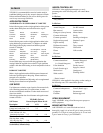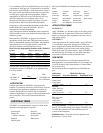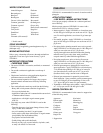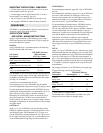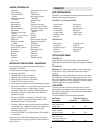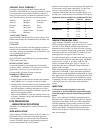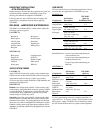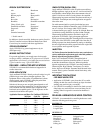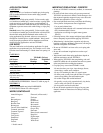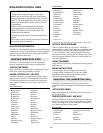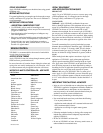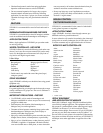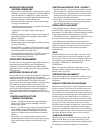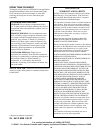
SPRAY EQUIPMENT
Apply VELPAR L uniformly over the desired area using ground
equipment only.
MIXING INSTRUCTIONS
For ground application, use enough water for thorough coverage
usually a minimum of 25 gal per acre. The use of a surfactant is
not recommended.
IMPORTANT PRECAUTIONS
- INDUSTRIAL UNIMPROVED TURF
• Use VELPAR L only in stands of bermudagrass and
bahiagrass established for at least one year. Do not treat newly
sprigged or sodded areas.
• Some discoloration of the bermudagrass or bahiagrass may
occur after application.
• Injury may result when desirable grasses are under stress from
drought, insects, disease, cold temperature, or poor fertility.
• Severe turf injury may occur if applications are made on
gravelly or rocky soils, thinly covered subsoils, or soils with
less than 1% organic matter.
VELPAR L is recommended for the control of undesirable
woody plants in noncrop sites.
APPLICATION TIMING
Apply VELPAR L from late winter through summer, prebud
break until new growth hardens off.
In areas where the soil remains frozen during the winter and
spring rains are usually inadequate for soil activation, a fall
or winter treatment may be applied before the soil freezes.
WOODY PLANTS CONTROLLED - USE RATE
2–4 Gal/Acre
*Partial control
SPRAY EQUIPMENT
AND APPLICATION TECHNIQUES
BROADCAST
Apply 2–4 gal of VELPAR L per acre as a coarse spray using
ground equipment only. Use enough water for thorough
coverage, usually a minimum of 25 gal per acre.
BASAL (SOIL)
Undiluted - Apply VELPAR L undiluted with an exact-
delivery handgun applicator. This equipment delivers a thin
stream of a predetermined volume when triggered. Apply
VELPAR L at the rate of 2–4 ml for each inch of stem
diameter at breast height. Do not exceed 4 gal of VELPAR L
per acre per year. Direct the treatment to the soil within 3 ft of
the root collar of woody plants to be controlled. When treating
large stems and when more than one delivery of VELPAR L is
needed per stem, make applications on opposite sides of the
stem.
For multi-stemmed and low-growing brush that have stem
diameters that are difficult to determine, apply VELPAR L at
the rate of 2–4 ml per 3" of canopy width. For tall, slender
(columnar) brush types, apply 4–8 ml per 3" of height. Base
the rate on whichever canopy dimension is greater (width or
height).
When treating brush that requires more than a single 4 ml
application of VELPAR L, apply subsequent applications
equally spaced around the plant. If treating brush on sloped
sites, apply most of the VELPAR L on the uphill side of the
stem. If treating resprouts from brush disturbed by cutting or
shredding, the rate of application should be proportional to the
original tree size, not just the small regrowth of sprouts.
Diluted - Mix one gal of VELPAR L with 5 or more gal of
water. Apply 2–4 gal of VELPAR L per acre. Direct the spray
to the soil in a serpentine pattern so that the swath on the soil
is 6–12" wide at the base of the brush. Swaths should be 2–4
ft apart.
IMPORTANT PRECAUTIONS - NONCROP
• Injury to or loss of desirable trees or other plants may result if
VELPAR L is applied or if equipment is drained or flushed on
or near desirable trees or other plants, on areas where their
roots may extend, or in locations where the chemical may be
washed or moved into contact with their roots.
• Prevent spray from drifting to desirable plants.
• Poor weed and brush control may result from the following:
–Use on poorly drained sites
–Applications made when the soil is saturated with water and
rain is imminent within 24 hours.
–Applications to soils high in organic matter (greater
than 5%).
• Following mechanical cutting or clearing, allow stumps and
injured trees sufficient time to adequately resprout before
applying VELPAR L.
• Do not use VELPAR L on frozen soils.
• Do not use VELPAR L on lawns, driveways, tennis courts, or
other residential or recreational areas.
Alder
American elm
Ash
Aspen
Balsam poplar
Birch
Black cherry
Blackgum
Catclaw acacia
Chinaberry*
Chinese elm
Chinese tallow
Deerbrush
Dogwood
Eastern red cedar*
Hackberry
Hawthorne
Hazel
Hickory
Huisache
Juniper
Locust
Lotebush
Manzanita
Mesquite
Mulberry
Multiflora rose
Myrtle
Oaks
Osage orange
Persimmon
Privet
Red maple
Sassafras*
Small soapweed
Snowbrush
Sourwood
Sumac
Sweet bay
Sweet gum
Whitebrush
Whitehorn
Wild plum
Willow
Yellow Poplar
BRUSH CONTROL
15



